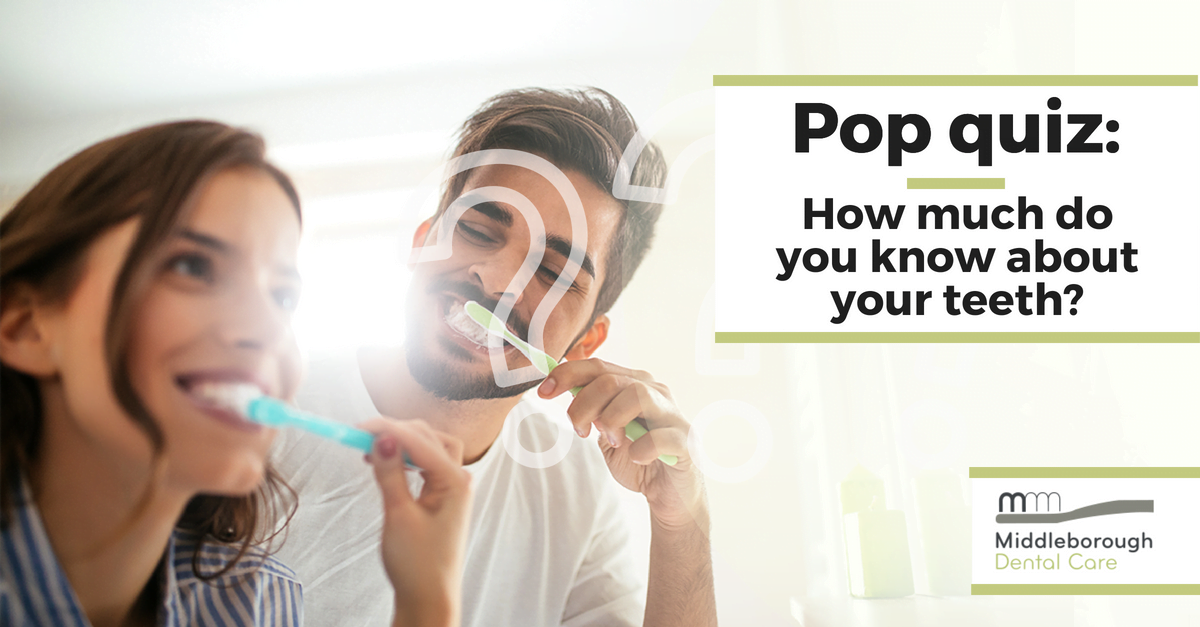
Pop quiz: How much do you know about your teeth?
Dentists get asked all sorts of questions – and we ask a few, too.
We’re very happy to answer your questions, because the more you know about your teeth, gums, and mouth, the more likely that you’ll do a good job of looking after your oral health.
Keep in mind that there are no silly questions: it’s much better for you to get accurate information from an expert than to go on without knowing or, even worse, operating under a misconception.
And don’t be embarrassed to ask. We’ve found that most people don’t know very much about their teeth, gums, and general oral health … perhaps because they’re happy to rely on dentists!
Just for fun, we’ve put together a short pop quiz – only six questions – to see how much you know about your teeth and mouth.
The answers are at the bottom of the page. Good luck!
-
How many teeth do you have?
Children have fewer teeth than adults. The first set of teeth are variously known as baby teeth, milk teeth, primary teeth, deciduous teeth, or temporary teeth. The maximum number of teeth includes wisdom teeth, although not all adults get those.
-
Can you name two different types of teeth?
We’re not looking for wisdom teeth as one of the answers, but rather the official designations. If you’ve ever wondered why wisdom teeth are called that, you’re not alone! They’ve been referred to as the “teeth of wisdom” since the 17th Century because they generally appear between the ages of 17 and 25, the so-called “age of wisdom”.
-
What are teeth made of?
This is a tricky question that most people can’t answer. Good for you if you can correctly name more than two of the four different types of tissue that make up a human tooth!
-
What do most people call their maxilla and mandible?
You might know one of these and then be able to figure out the other, especially if you were taught that little rhyme that names your cranium, clavicle, scapula, sternum, ulna, radius, humerus, femur, fibula, tibia, and so on.
-
What’s the difference between gingivitis and periodontal disease?
According to research, as many as 30 percent of people may be at risk genetically, no matter how good their oral care routine. If you have periodontal disease, bacteria travels into your bloodstream which has all sorts of more serious health implications, including heart disease, stroke, and diabetes.
-
What causes cavities?
A question with a quite complex answer, there are really two key ‘ingredients’ … let’s call them A and B (yes, that’s a clue)!
The answers are below … :
-
How many teeth do you have?
Children have 20 teeth, adults 32.
-
Can you name two different types of teeth?
The incisors are in the middle, alongside them are canines, with premolars next, then molars (including wisdom teeth) toward the back.
Each type of tooth serves a different function in the chewing process. Incisors cut foods when you bite into them, while the sharper and longer canines tear food. The premolars, which are flatter than the canines, grind and mash food and molars, with their points and grooves, are responsible for the most vigorous chewing.
-
What are teeth made of?
Human teeth are made up of four different types of tissue: pulp, dentin, enamel, and cementum. The pulp is the innermost portion of the tooth and consists of connective tissue, nerves, and blood vessels, which nourish the tooth. Dentin surrounds the pulp with enamel on the outside, while cementum covers the outside of the root, below the gumline.
-
What do most people call their maxilla and mandible?
Your maxilla is your upper jawbone and the mandible is the lower jawbone, so together they form your jaw.
-
What’s the difference between gingivitis and periodontal disease?
Gingivitis is the early inflammation of the gums; periodontal disease, or periodontitis, represents the more severe form of jaw bone damage. They’re two different ways to refer to gum disease (‘gingiva’ is the medical term for gums), which is the major cause of tooth loss in adults. It can be painless and may go undetected, but the bacterial growth destroys gum tissue, gums begin to recede, and the jawbone can deteriorate.
-
What causes cavities?
B for bacteria and A for acid.
Having bacteria in your mouth is a normal thing and some types are helpful. However, certain types of bacteria can attach themselves to hard surfaces like the enamel that covers your teeth.
If they’re not removed, they multiply and grow in number until a colony forms. Proteins in your saliva mix in and the bacteria colony becomes a whitish film on the tooth – what we call plaque.
When refined carbohydrates or sugars are eaten, the bacteria in your mouth use the sugar and convert it to acid that dissolves tooth enamel.
* * *
How did you go?
Don’t worry if you found them hard. Just remember, we’re here to answer any questions … and to know all this stuff back to front, so you don’t have to.
And also remember that prevention is better than cure, so come in for regular check-ups.
We’ll see you soon.